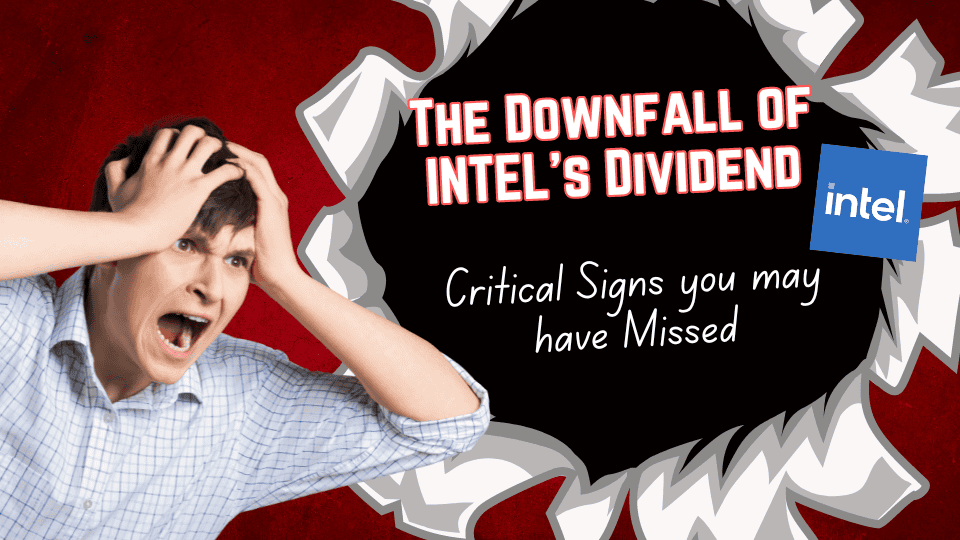Introduction
Intel Corporation ($INTC) has long been a stalwart in the tech industry, with a history of innovation and a reputation for stability. However, recent developments have left investors reeling, particularly those who relied on Intel’s dividend as a source of income. In this article, we’ll explore the key metrics and warning signs that led to the suspension of Intel’s dividend. If you’re an investor in dividend-paying stocks, this is a story you won’t want to miss.
The Decline of $INTC’s Stock Price
Intel’s stock price currently sits at $20.49, down a staggering 55.44% over the last five years. This decline isn’t just in the stock price; Intel’s total return, which includes dividends, is also down 50.01% over the same period. Such a dramatic drop should be a red flag for any investor, especially those focused on dividend stocks.

The First Cut: A 64% Reduction in May 2023
In May 2023, Intel shocked its shareholders by cutting its quarterly dividend by 64%, from $0.37 to $0.13. For a company that had been increasing its dividend by a modest 4% annually for over a decade, this move was alarming. The annual raises, though consistent, barely outpaced inflation, making the dividend less attractive over time. The 64% cut was just the beginning of what was to come.
The Final Blow: Dividend Elimination in August 2024
The most significant development came in the third quarter of 2024 when Intel announced it would be suspending its dividend altogether. This decision marked the end of an era for Intel, which had been a reliable dividend payer. But why did it happen?
The Warning Signs: Payout Ratio and Free Cash Flow
One of the early indicators of trouble was Intel’s dividend payout ratio, which skyrocketed from around 30% to 100% in 2023. This steep increase began in August 2022 and should have been a clear warning sign for investors. A payout ratio of 100% means that Intel was paying out all of its earnings as dividends, leaving no room for reinvestment or financial cushioning.

Another critical metric that foreshadowed the dividend cut was Intel’s free cash flow (FCF). FCF is the cash generated by a company after accounting for capital expenditures. It’s a crucial indicator of a company’s ability to pay dividends. Since January 2021, Intel’s FCF has been on a steady decline and has yet to recover. Without strong cash flow, maintaining a dividend becomes increasingly difficult, as Intel’s shareholders have now experienced firsthand.

The Debt Dilemma: A 4,200% Increase Over 15 Years
Intel’s financial troubles aren’t limited to dividends and cash flow. Over the last 15 years, the company’s debt has skyrocketed by over 4,200%. As of now, Intel carries more than $52 billion in debt. This massive debt burden has undoubtedly contributed to the company’s financial strain and its inability to sustain dividend payments.

The P/E Ratio: A Sign of Overvaluation?
Another metric that raises concerns is Intel’s price-to-earnings (P/E) ratio, which currently stands at a whopping 85x, compared to the sector average of around 44x. The P/E ratio is a measure of a company’s current share price relative to its earnings per share (EPS). A high P/E ratio can indicate that a stock is overvalued or that investors are expecting high growth rates in the future. In Intel’s case, the high P/E ratio suggests that the stock may be overpriced, especially given the company’s recent performance.

Intel’s Future: A Cautious Outlook
Despite the dividend suspension, Intel has stated its commitment to paying a competitive dividend in the future, contingent on improved cash flows. While this may offer some hope to investors, it’s important to remain cautious. Intel will need to refocus its business model and return to profitability before it can become a reliable dividend stock once again.
Conclusion: A Cautionary Tale for Dividend Investors
The fall of Intel’s dividend is a stark reminder of the importance of paying attention to key financial metrics. From the payout ratio to free cash flow, these indicators provided early warnings that were easy to overlook. As Intel works to rebuild, investors should carefully consider whether $INTC is a suitable addition to their portfolios, especially if dividend income is a priority.
If you’re interested in learning more about dividend investing and how to spot potential red flags in your portfolio, subscribe to our newsletter for regular insights and updates! Don’t forget to check out our in-depth resource center where we compiled all of our best content in one place!

